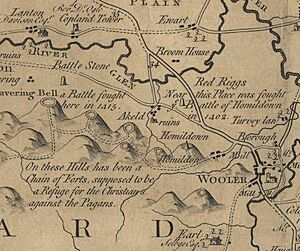Battle of Homildon Hill facts for kids
Quick facts for kids Battle of Holmedon Hill |
|||||||
|---|---|---|---|---|---|---|---|
|
|||||||
| Belligerents | |||||||
| Commanders and leaders | |||||||
| Strength | |||||||
| 12,000 | 12,000 | ||||||
| Casualties and losses | |||||||
| Very high | Somewhat low | ||||||
The Battle of Holmedon Hill was a major conflict between the English and Scottish armies. It took place on September 14, 1402, in Northumberland, England. This important battle is even mentioned in Shakespeare's famous play, Henry IV, part 1. Today, the battle site is known as Humbleton Hill.
Contents
Why Did the Battle Happen?
Before this battle, both England and Scotland often raided each other's lands. On June 22, 1402, a small group of Scottish raiders was defeated at the Battle of Nesbit Moor. The Scottish leader, Archibald Douglas, 4th Earl of Douglas, decided to get revenge.
Douglas was a very powerful military leader in Scotland. He led a large army of about 10,000 men into England. They marched all the way to Newcastle, destroying everything in their path.
The Battle Unfolds
The Earl of March convinced Henry Percy and his son, Harry "Hotspur", to wait for the Scots near Wooler. The Scottish army set up camp in a low area called Milfield. But the English army quickly moved to attack.
The Scots had good lookouts. They managed to retreat to the higher ground of Homildon Hill. There, they formed their traditional battle formations called schiltrons. A schiltron was a tight group of soldiers with long spears pointing outwards. This was meant to protect them from cavalry.
However, the schiltrons were big targets for the English longbowmen. The English archers fired many arrows, breaking the Scottish formations. About a hundred Scottish soldiers, led by Sir John Swinton, decided to charge the English. They said it was "Better to die in the mellay than be shot down like deer." Sadly, all of them died.
Douglas hesitated to send his main force forward. By the time he did, it was too late. His army was already badly hurt by the arrows. The Scots then met the fresh English soldiers and were completely defeated. Many important Scottish leaders were captured. This included Douglas himself, who was wounded five times and lost an eye.
What Happened After the Battle?
Many Scottish leaders were taken prisoner after the battle. This left Scotland in a difficult spot. Luckily for Scotland, the English King Henry IV had his own problems. He was dealing with issues inside England and a rebellion in Wales. So, he didn't launch a full invasion of Scotland.
King Henry IV did not want the captured Scottish soldiers to return to Scotland and fight him again. So, he refused to let the English nobles ransom their prisoners. This meant the English nobles couldn't get money for their captives.
This decision made the Percy family, who had captured many Scots, very angry with the King. In 1403, the Percys joined forces with Owain Glyndŵr and rebelled against King Henry. Hotspur freed his Scottish prisoners, including Douglas. Many of them decided to join Hotspur's rebellion. Douglas even fought alongside Hotspur at the Battle of Shrewsbury, where he was wounded again.
Shakespeare's Account of the Battle
The Battle of Holmedon Hill is famously mentioned in Shakespeare's play, Henry IV, part 1. Here's a part of what he wrote:
Here is a dear, a true industrious friend,
Sir Walter Blunt, new lighted from his horse.
Stain’d with the variation of each soil
Betwixt that Holmedon and this seat of ours;
And he hath brought us smooth and welcome news.
The Earl of Douglas is discomfited:
Ten thousand bold Scots, two and twenty knights,
Balk’d in their own blood did Sir Walter see
On Holmedon’s plains. Of prisoners, Hotspur took
Mordake the Earl of Fife, and eldest son
To beaten Douglas; and the Earl of Athol,
Of Murray, Angus, and Menteith:
And is not this an honourable spoil?
A gallant prize? ha, cousin, is it not?---Shakespeare, Henry IV, part 1, act 1, scene 1.
Who Was Lost or Captured?
Notable Scottish Casualties
- Sir Adam de Gordon, a Scottish Captain
- Sir John Swinton, 14th of that Ilk, a Scottish Captain
- Sir John Livingstone of Callendar
- Sir Alexander Ramsay of Dalhousie
Notable Scottish Captives
- Archibald Douglas, 4th Earl of Douglas
- Murdoch Stewart, Earl of Fife
- Thomas Dunbar, 5th Earl of Moray
- George Douglas, 1st Earl of Angus
- Henry Sinclair, 2nd Earl of Orkney
The Battle Site Today
The place where the battle happened is now part of the Northumberland National Park. At the top of the hill, you can still see the remains of an Iron Age hillfort. This fort was built about 1500 years before the battle. During the Middle Ages, people used the ruined fort's sides for summer homes and sheep shelters.
There is also a large stone called the Battle Stone. People used to think it was put there to remember the 1402 battle. However, it is actually a much older standing stone from the Bronze Age.



